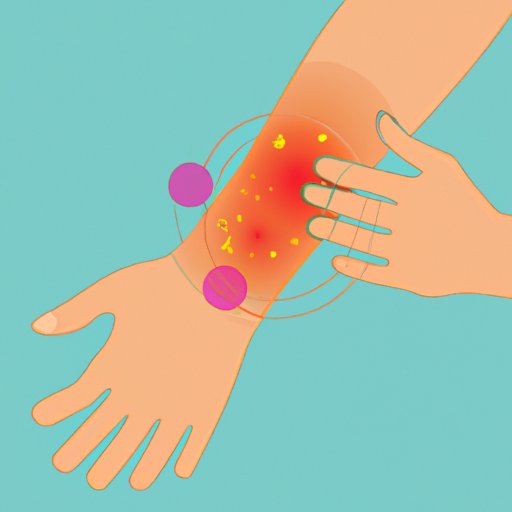Introduction
Rheumatoid arthritis (RA) is a chronic autoimmune disease that affects millions of people worldwide. This disease causes inflammation in the joints, leading to pain, stiffness, and swelling. Research proves that RA is an autoimmune disease, meaning that the body’s immune system mistakenly attacks healthy cells in the body. Hence, it is essential to understand the relationship between autoimmune diseases and RA. This article aims to provide an in-depth analysis of RA as an autoimmune disease, discussing its causes, symptoms, diagnosis, treatment, and management.
The Link between Autoimmune Diseases and Rheumatoid Arthritis: What You Need to Know
Autoimmune disease is a condition in which the immune system mistakenly attacks healthy cells in the body, thinking that they are foreign invaders. RA is a systemic autoimmune disease that affects the joints in the hands, feet, and wrists, causing inflammation. Like other autoimmune diseases, RA occurs when the body’s natural defense system malfunctions and begins attacking its tissues and organs.
The causes of RA are not fully understood, but scientists believe it is a combination of genetic, environmental, and lifestyle factors. People who have a family with a history of autoimmune diseases are more likely to develop RA. Environmental factors such as smoking and exposure to pollution are known to trigger the disease’s onset. Inflammation, one of the immune system’s responses, plays a central role in the development of RA.
Understanding Rheumatoid Arthritis as an Autoimmune Disease
RA occurs when the immune system mistakenly attacks the synovial lining, the thin membrane that lines the joints. The attack triggers the release of cytokines and antibodies, which causes inflammation in the joints and surrounding tissues. Over time, the inflammation can cause joint deformity and lead to irreversible damage. Common signs and symptoms of RA include joint pain, stiffness, and swelling, fatigue, and weight loss. Although the symptoms differ among individuals, they all stem from the immune system’s response, which is an essential factor in the diagnosis of RA.
Diagnosing RA involves a combination of medical history, physical examination, laboratory tests, and imaging studies. Blood tests can detect the presence of specific antibodies associated with RA, such as rheumatoid factor (RF) and anti-CCP. Imaging tests such as X-rays, CT Scans, and MRIs can identify the extent of the joint damage. Treatment options for RA aim at reducing inflammation, relieving symptoms, and preventing joint damage. Medications such as nonsteroidal anti-inflammatory drugs (NSAIDs), disease-modifying anti-rheumatic drugs (DMARDs), and biologic response modifiers (biologics) can help achieve these goals.
The Science Behind Rheumatoid Arthritis
Autoimmune diseases such as RA are complex disorders that involve multiple cellular and molecular mechanisms. One of the central mechanisms in the development of RA is inflammation, which is the immune system’s response to danger signals. Inflammation plays a vital role in the disease process in RA, and it results in joint destruction and erosion. Cells of the immune system such as T and B cells participate in the inflammatory response and cause joint damage.
The current scientific research in the field focuses on finding ways to regulate the immune response and its associated inflammation. Researchers explore different avenues such as cytokine inhibitors, gene therapy, and cell-based therapies to treat RA. These therapies are promising, but they are still in the investigative phase, and more research is needed before they become mainstream treatment options.
Natural Remedies and Management of Rheumatoid Arthritis as an Autoimmune Disease
There are natural remedies and home therapies that can help manage RA symptoms. These include changes in lifestyle factors such as stress management, regular exercise, and a healthy diet. Additionally, herbs, supplements, essential oils, and other alternative therapies can help reduce the symptoms and ease the effects of RA.
Some common natural remedies used for RA include omega-3 fatty acids, turmeric, ginger, and probiotics. Supplements such as Vitamin D, Calcium, and B-complex vitamins can also aid in reducing inflammation and promoting overall health. Lifestyle modifications such as reducing stress, getting enough rest, and regular physical activity can help manage the disease’s symptoms.
Rheumatoid Arthritis and Its Link to Other Autoimmune Illnesses
RA is not an isolated disease process, and it is linked to other autoimmune diseases such as lupus and Sjogren’s syndrome. Over time, people with RA have a higher risk of developing additional autoimmune conditions. The genetic code that predisposes people to develop such conditions is complex, and researchers are working to understand the mechanisms underlying the genetic factors. It is essential to monitor the symptoms and seek early medical advice for potential co-occurring autoimmune illnesses.
Conclusion
RA is an autoimmune disorder that affects the joints and causes pain and inflammation. Research confirms that like other autoimmune diseases, RA occurs when the body’s immune system malfunctions and attacks its tissues and organs. While there is no cure for RA, early diagnosis and management can reduce joint damage and improve quality of life. Lifestyle changes such as regular exercise, stress reduction, and a healthy diet, along with natural remedies and traditional treatment modalities, can help manage RA’s symptoms. People with RA should work closely with their healthcare provider to get the best possible medical care and support.
